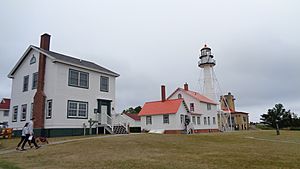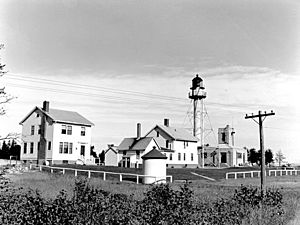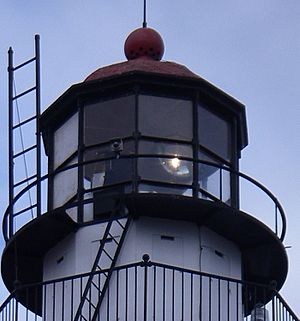Whitefish Point Light facts for kids
 |
|
| Whitefish Point Light in July 2018 | |
| Location | Whitefish Point Whitefish Township, Michigan |
|---|---|
| Coordinates | 46°46′14″N 84°57′24″W / 46.77056°N 84.95667°W |
| Year first lit | 1849 |
| Automated | 1971 |
| Foundation | Pier |
| Construction | Steel |
| Tower shape | Lattice Tower |
| Height | 76 feet (23 m) |
| Focal height | 80 feet (24 m) |
| Original lens | 3rd order Fresnel Lens (original), Light-emitting diode (LED) lantern (current) |
| Intensity | RACON: O (– – –). Standby light of reduced intensity. |
| Range | 15 nautical miles (28 km; 17 mi) |
The Whitefish Point Light is a famous lighthouse in Michigan, USA. It stands on the southeastern shore of Lake Superior, right at the tip of Whitefish Point. This important lighthouse helps guide ships into and out of Whitefish Bay.
Built in 1849, it is the oldest working lighthouse in Michigan's Upper Peninsula. Every ship traveling on Lake Superior must pass by Whitefish Point. This area is sometimes called the "Graveyard of the Great Lakes" because many ships have wrecked here, including the famous SS Edmund Fitzgerald.
Today, the lighthouse is part of the Great Lakes Shipwreck Museum. This museum displays many items from shipwrecks found in the Whitefish Point Underwater Preserve, including the bell from the SS Edmund Fitzgerald. The lighthouse itself is recognized as a special historical place, listed on the National Register of Historic Places since 1973.
Contents
The Lighthouse's Story
The first lighthouse at Whitefish Point was built in 1847 and first lit in 1849. It was one of the very first lighthouses on Lake Superior. This light is still the oldest active one on the lake. It marks a crucial turn for ships sailing along Lake Superior's southern coast, an area known for its many shipwrecks. All vessels entering or leaving Lake Superior rely on this light.
The original light used special lamps called Lewis lamps. Later, it was updated with a Fresnel lens, which made the light much brighter and more focused. The tower you see today was built in 1861. It has a strong iron frame designed to withstand powerful winds.
In 1968, the light was changed again to a powerful aero beacon. This beacon could be seen for about 26 nautical miles (about 30 miles) on a clear day. It flashed twice within every 20 seconds.
Modernizing the Light
The lighthouse became automated in 1971, meaning no one had to live there to operate it anymore. In 2011, the old aero beacon was replaced with a modern light-emitting diode (LED) lantern. This new light has a range of about 15 nautical miles. The old aero beacon is now kept at the Great Lakes Shipwreck Museum for people to see.
Shipwreck Museum and History
The Great Lakes Shipwreck Museum is located right at the lighthouse. It holds many artifacts from shipwrecks in the Whitefish Point Underwater Preserve. The most famous item is the bell from the SS Edmund Fitzgerald, recovered in 1995. The museum is open during the tourist season, usually until October 31st each year.
Whitefish Point is a very important historical site. An official Michigan Historical Marker was placed here in 1974. It tells visitors that this light is the oldest on Lake Superior. It also mentions that the point was a stopping place for Native Americans, Voyageurs, and missionaries long ago.
Lighthouse Keepers
Many dedicated people worked as lighthouse keepers at Whitefish Point, making sure the light stayed on to guide ships. Some of the keepers included:
- 1848–1851: James B. Van Rensselaer
- 1851–1853: Amos Stiles
- 1853–1856: William C. Crampton
- 1856–1859: Belloni McGulpin
- 1859–1861: Charles Garland
- 1861–1864: Joseph Kemp
- 1864–1868: Thomas Stafford
- 1868–1874: Edward Ashman
- 1874–1882: Charles J. Linke
- 1882–1883: Edward Chambers
- 1883–1903: Charles Kimball
- 1903–1931: Robert Carlson
Famous Shipwrecks
The waters around Whitefish Point are known as the "Graveyard of the Great Lakes" because so many ships have sunk there. Some of the shipwrecks found in Whitefish Bay include:
- Comet
- John B. Cowle
- Drake
- Samuel Mather
- Miztec
- Myron
- Niagara
- John M. Osborn
- Sagamore
- Superior City
- Vienna
These shipwreck sites are protected in the Whitefish Point Underwater Preserve. This helps preserve them for future generations of divers and explorers.
Nature and Wildlife at Whitefish Point
Whitefish Point is not just important for ships; it's also a vital place for nature. The Whitefish Point Unit of the Seney National Wildlife Refuge provides a crucial resting and feeding spot for many migrating birds. This includes raptors (like eagles and hawks), waterbirds, and songbirds. Whitefish Point is recognized as an Important Bird Area.
The Whitefish Point Bird Observatory is a research and education center here. It works with Michigan Audubon to study and protect birds. Whitefish Point is considered one of the best places in North America to see the saw-whet owl. Most of Whitefish Point is a wildlife sanctuary, famous for the many different kinds of birds that pass through.
Visitors can explore trails and a wooden walkway to observe wildlife. Birdwatchers often come here to spot migrating birds such as eagles, Northern goshawks, geese, falcons, hawks, and owls.
The sandy beach at Whitefish Point is also a great place to look for unique stones called banded agates, especially after a storm. You can also enjoy a peaceful walk along the shore of Lake Superior. In recent years, piping plovers, a type of shorebird, have successfully nested and raised their young at Whitefish Point.
To visit the Whitefish Point Lighthouse, you can drive north on Whitefish Point Road for about 11 miles from M-123 in Paradise. The route is clearly marked.
See also
- Lighthouses in the United States
- Great Lakes Storm of 1913 and Shipwrecks of the 1913 Great Lakes storm




